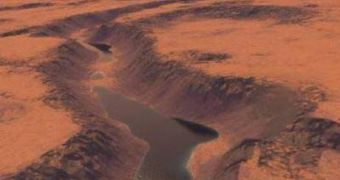When the Phoenix Mars Lander first set its metallic feet on the surface of the Red Planet, it almost instantly struck gold, or, even better, ice. This led astronomers to infer the existence of ice shelves on our neighboring planet, which means that, at some point, all those amounts of ice must have flowed on the surface, when Mars' orbit was seeing better days. In a new, remarkable and groundbreaking find, researchers at the University of Colorado in Boulder (UCB) claim that they've found the first “definitive evidence of shorelines on Mars,” following multiple studies claiming the same thing, but with little scientific merit.
UCB Astronomer Gaetano Di Achille said that the lake his team identified was about as deep as Lake Champlain bordering the United States and Canada, with an average depth of 1,500 feet. The formation covered an area of about 80 square miles, and existed more than three billion years ago. Many studies over the past few years have advocated that, at some point in its history, Mars supported liquid water, which automatically meant that it could have supported life as well. However, evidence of organic molecules on its surface has remained elusive, and the studies were only considered hypotheses.
If the new find turns out to be true, then it could mean that the area, now completely dry, could be the best place to start a search for extraterrestrial life forms. If bacteria, microbes, or even more complex life forms existed on the Red Planet, then they would have most likely be concentrated either in/under the water, or in a small area around it. Future ground exploration probes, featuring chemical detectors that could pick up signs that organic matter gives out when it decays, could make considerable breakthrough, and could finally prove if life can, indeed, appear as easily as some believe it can.
“This is the first unambiguous evidence of shorelines on the surface of Mars. The identification of the shorelines and accompanying geological evidence allows us to calculate the size and volume of the lake, which appears to have formed about 3.4 billion years ago,” Di Achille added, quoted by Space. The research was published in the latest issue of the American Geophysical Union's journal Geophysical Research Letters. NASA's Mars Reconnaissance Orbiter (MRO) supplied the investigators with the materials they needed, through its High Resolution Imaging Science Experiment, or HiRISE camera.
“On Earth, deltas and lakes are excellent collectors and preservers of signs of past life. If life ever arose on Mars, deltas may be the key to unlocking Mars' biological past,” the UCB expert concluded, underlining the necessity of a future robotic expedition in the area.

 14 DAY TRIAL //
14 DAY TRIAL //